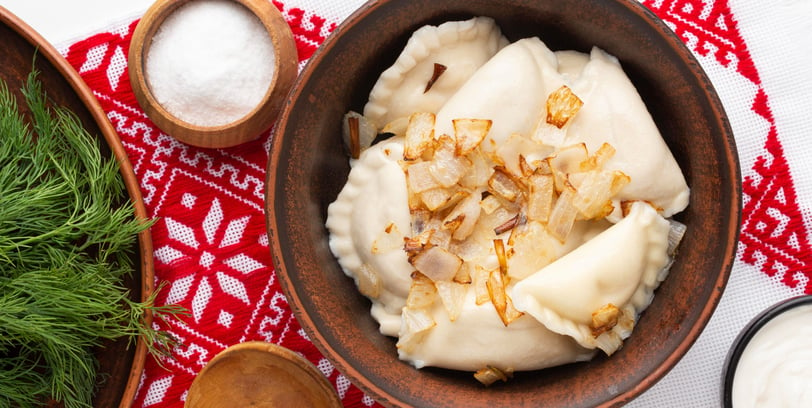Sourdough Pierogies
A Comforting Classic with a Fermented Twist Using Discard
RECIPESDISCARD
6/23/20253 min read


If you’ve been wondering what to do with your extra sourdough discard, let me introduce you to one of the most comforting, satisfying, and delicious solutions: sourdough pierogis. These humble Polish dumplings, typically filled with potatoes, cheese, or savory meats, are given an artisanal update with a sourdough discard dough that is soft, pliable, and just a little bit tangy.
Combining the hearty, satisfying nature of traditional Eastern European cuisine with the goodness of fermented sourdough, this recipe is perfect for both cozy family dinners and make-ahead freezer meals. While sourdough discard usually finds its way into pancakes or crackers, using it in pasta-style doughs like pierogi wrappers is a game-changer.
This post will walk you through every step of the sourdough pierogi process—from making the soft dough to prepping your favorite fillings and cooking them to golden, pan-fried perfection. We’ll also cover freezing tips, flavor variations, and creative serving ideas. Let’s dive in!
Ingredients
For the Dough (using sourdough discard):
1/2 cup sourdough discard (unfed)
2 cups all-purpose flour
1/3 cup warm water (as needed)
1 egg
1 tbsp olive oil or melted butter
1/2 tsp salt
For a Classic Potato & Cheese Filling:
2 medium russet potatoes, peeled and cubed
1/2 cup shredded cheddar or farmer's cheese
1/4 tsp salt
1/4 tsp pepper
1 tbsp sour cream or cream cheese (optional, for creaminess)
To Finish:
1–2 tbsp butter
Sliced onions or shallots (optional, for topping)
Fresh herbs like dill or parsley
Step-by-Step Instructions
1. Make the Dough
In a large bowl, combine the flour and salt. In a separate bowl, whisk the sourdough discard, egg, oil, and a bit of water. Slowly pour the wet into the dry and mix until a shaggy dough forms. Knead for 5–7 minutes until smooth and elastic. Cover with a towel and let rest for 30–60 minutes at room temperature.
2. Make the Filling
While the dough rests, boil the potatoes in salted water until fork-tender. Drain and mash until smooth. Stir in cheese, salt, pepper, and any optional sour cream or cream cheese. Cool to room temperature before using.
3. Roll and Fill
Divide the rested dough in half and roll out on a lightly floured surface until it’s about 1/8-inch thick. Use a 3-inch round cutter or glass to cut circles. Place a heaping teaspoon of filling in the center of each, fold into a half-moon, and pinch the edges to seal. Crimp with a fork if desired.
4. Cook the Pierogis
Bring a large pot of salted water to a boil. Drop pierogis in, 5–6 at a time, and cook until they float to the top (about 2–3 minutes). Remove with a slotted spoon.
For extra flavor, pan-fry the boiled pierogis in a skillet with butter and onions until golden and crispy.
Tips for Perfect Sourdough Pierogis
Rest the dough: Even with discard, a short rest improves elasticity.
Don’t overfill: Too much filling will burst your dough when boiling.
Seal well: Press out any air and pinch tightly to avoid leaks.
Use cold filling: Warm filling can soften the dough prematurely.
Pan-fry for texture: A golden sear makes pierogis irresistible.
Flavor Variations
Savory Options:
Sauerkraut and mushrooms
Spinach and feta
Bacon and caramelized onion
Ground beef and herbs
Sweet Pierogis:
Sweetened farmer’s cheese with cinnamon
Mashed blueberries with sugar and lemon zest
Apple and brown sugar filling
How to Freeze Pierogis
Lay uncooked pierogis on a floured baking sheet and freeze until solid. Then transfer to a zip-top bag or container. Boil straight from frozen—just add an extra minute or two to the cook time.
Serving Suggestions
Serve with caramelized onions, sour cream, or applesauce.
Add a side of sausage, roasted veggies, or sauerkraut.
Turn leftovers into pierogi casseroles or bake with cheese.
Make a “pierogi bar” for gatherings with multiple fillings and toppings.
Why Use Sourdough Discard?
Sourdough discard adds a subtle tang, improves texture, and makes use of something that often gets tossed. It enhances the dough’s depth of flavor while maintaining a soft and workable texture—ideal for pierogi wrappers.
Plus, you reduce waste and get the added nutritional benefits of fermented flour. Win-win.
Final Thoughts
Sourdough pierogis are cozy, comforting, and customizable. Whether you’re trying to use up discard or want to experiment with new ways to enjoy sourdough, this pierogi recipe delivers big time. From the first buttery, crispy bite to the soft, cheesy center—this dish is bound to become a family favorite.
Make a double batch and freeze some for busy nights, or gather friends for a pierogi-making party. However you do it, you’ll appreciate the old-world comfort with a modern sourdough flair.
Sourdough
Explore delicious sourdough recipes and tips today!
Make sure to follow us on our social media platforms!
contact us
Sourdough
theivoryoven.co@gmail.com
© 2025. All rights reserved.
